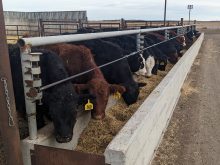The many changes in a short time to the Canadian Cattle Identification Agency tagging system are frustrating to many in the industry. This is exacerbated by the CCIA’s apparent lack of fiscal responsibility to farmers in these trying times.
Technology is improving so the transition to the radio frequency ID tags was going to be a natural one.
But why the rush? Adoption of the bar-coded tags was going smoothly with a high compliance rate. Producers in most cases had used them as their management tags so the extra cost was negligible.
Read Also

Topsy-turvy precipitation this year challenges crop predictions
Rainfall can vary dramatically over a short distance. Precipitation maps can’t catch all the deviations, but they do provide a broad perspective.
Retention was the same as tags in the past. However, when performing BSE tests, I have noticed many cows in small herds do not carry any tag for identification. This is a situation we all must work to rectify.
The RFID tags could have been phased in gradually, especially in light of the cattle industry’s difficult economics. Currently, RFID tags have minimal advantage to our producers, are an extra thing to apply and will cost $3 or more.
Their retainability, however, will be better because they are smaller. In the future they may be looked on favourably by our export markets.
Only large operators will invest in the technology to read the tags.
For now, the benefit is with the packing plants that can read the RFID tags automatically, but it is the cow-calf producer who foots the bill.
I believe the identification agency is catering to the packer’s needs far more than the producer’s.
We have two microchip readers at our clinic to read the chips put in horses, alpacas, llamas, dogs and cats.
Neither of these units will read the cattle RFID tags. I am sure that with the right selection of technology these could have been compatible.
Another problem is that the chip has to be within 30 centimetres of the reader.
If we had waited, I’m sure tools would be developed that can read several cattle at a time and from a distance. Then tracking will carry on through auction markets and community pastures.
The United States still does not have any national system in place, so Canada’s bar-code tags are already far ahead of the U.S. system.
A deadline was imposed of July 1 after which no bar-code tags are to be sold.
Another problem regards cows. Initially, CCIA said bar-code tags were acceptable for the life of the animal. This made sense because as the old cows were eliminated, more of the cow herd would have the RFID tags. Mature cows and bulls are all slaughtered in Canada and this may continue for several years, so why the rush to retag with RFID?
As recently as in its winter 2005 newsletter, CCIA chair Mabel Hamilton wrote “when RFID came into effect as of January 2005, cattle that are already identified with a bar-coded tag will not have to be retagged.”
Now the rule has been changed again. As of Sept. 1, 2006, all cattle, meaning cows, calves and bulls, leaving the herd of origin need an RFID tag attached. Existing bar-code tags must not be removed.
I profess it is hard to have faith in an organization that keeps changing its own rules.
The other twist is if cattle leave their herd of origin before Sept. 1, 2006, tags will be recognized at least until Dec. 31, 2007.
How can this possibly be enforced and even if it can, why the double standard? What is the difference if you feed your own calves out or sell them to a feedlot?
One could argue there is more tracking involved and possibly more expense with cattle trading hands than those finished on the farm of origin. Again the cow-calf producer is footing more expense.
In spite of all the push to use CCIA tags, in some situation they are not required.
BSE testing by veterinarians does not require the cow or bull have a tag. If there is one, we record it but we do not need to insist a tag is present.
Many producers have questioned me on this but my response is to not waste a new tag on a dead animal when it is not mandatory.
Before BSE and just after CCIA tags were implemented, even the Canadian Food Inspection Agency preferred the old style metal ear tag. Even today in a few auction markets where brucellosis testing still occurs, the metal tags are being used and CCIA tags are not being read.
The tagging system should make it unnecessary to brand cattle once exporting to the U.S. resumes. It seems inhumane to me to have to brand cattle with a CAN when each animal will have an individual identification anyway.
The ability to voluntarily enter birth data is good and should help our cause in the future.
Roy Lewis is a veterinarian practising in Westlock, Alta.














